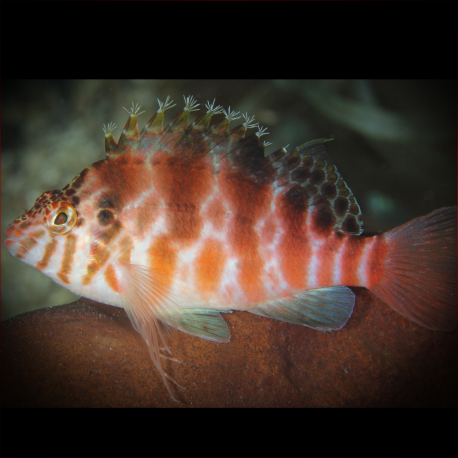More info
Datasheet
| Minimum Tank Size | 100 litres / 26.42 US gallons |
| Maximum Size | 10.0cm / 3.94inches |
| Reef Compatible | Reef safe with caution |
| Temperament | Aggressive towards other species |
| Temperature | 22.2°C / 71.96°F - 25.6°C / 78.08°F |
| Specific Gravity | 1.020-1.025 |
| Carbonate Hardness | 8-12 |
| pH | 8.1-8.4 |
General Description:The Coral Hawkfish, also known as the Spotted Hawkfish or Pixy Hawkfish, belongs to the Cirrhitidae family. It can be distinguished by its distinctive spots under the eye, setting it apart from similar species. These fish are typically found in the East Indian Ocean, West Indian Ocean, Australia, The Red Sea, Indonesia, and various parts of the Pacific Ocean.
Aquarium Suitability:Suitable for aquaria with caution, the Coral Hawkfish can be kept in small tanks if adequately equipped to meet its needs. It is advised to house them in larger tanks to ensure their well-being. These fish can be aggressive towards smaller and peaceful species, as well as crustaceans like shrimps and crabs.
Demands, Care, and Hardiness:Hardy in nature, Coral Hawkfish do not impose strict demands on water quality. They require hiding places within live rocks and appreciate ample space in the tank to exhibit behavioral traits optimally. Regular feeding, sufficient hiding spots, and generous space can help reduce their aggressive tendencies to some extent.
Reef Suitability:Considered reef safe with caution, these Hawkfish may display some threatening behavior towards smaller fish and crustaceans typically found in reef environments.
Aquarium Setup:When setting up an aquarium for Coral Hawkfish, ensure the tank is spacious enough to accommodate their aggressive behavior. Providing ample hiding spaces, such as live rocks, is essential for their well-being. Maintain water parameters with a temperature range of 22.2-25.6°C, pH of 8.1-8.4, and specific gravity between 1.020-1.025.
Behaviour:Coral Hawkfish are known for their fun and interesting personality. They may coexist as a pair if introduced simultaneously, and some species within the Cirrhitidae family have the ability to change gender from female to male.
Feeding and Diet:These fish have a varied diet, consuming larger crustaceans like shrimp and crabs, as well as smaller crustaceans such as krill, mysis, and artemia. Providing a diverse diet is crucial for their nutritional needs.
Dimorphism and Captive Reproduction:Coral Hawkfish can exhibit dimorphism, with females changing sex to males as needed. This species may engage in captive reproduction under suitable conditions.
Habitat and Distribution:In the wild, Coral Hawkfish can be found in the Indo-Pacific region, from the Red Sea to South Africa, extending east to the Marquesan Islands and north to the Mariana Islands. They are also present in the Eastern Pacific, ranging from the Gulf of California to Colombia and the Galapagos Islands.

